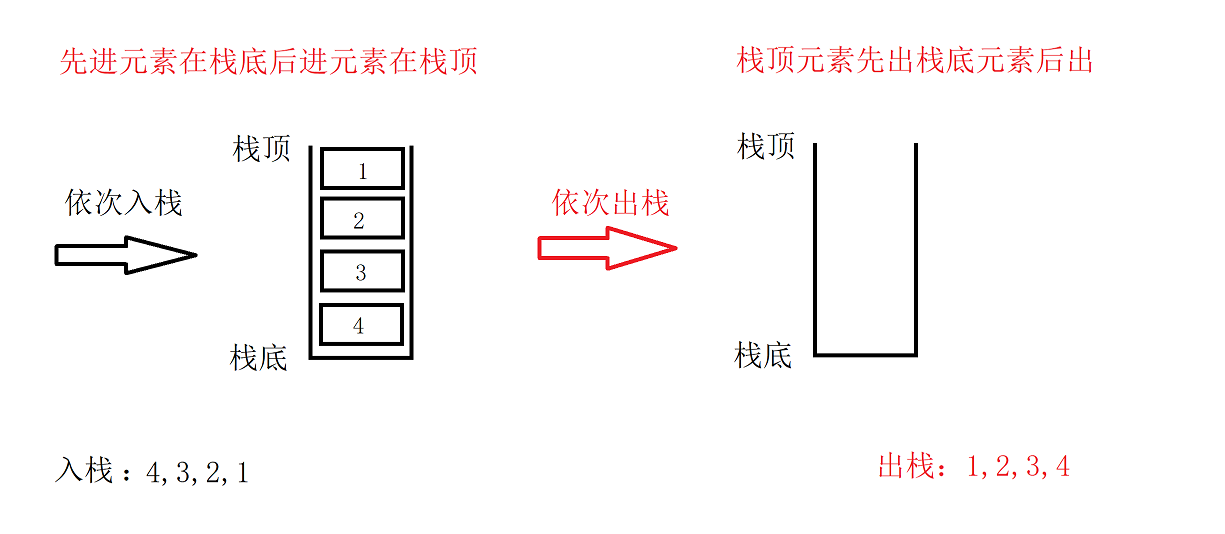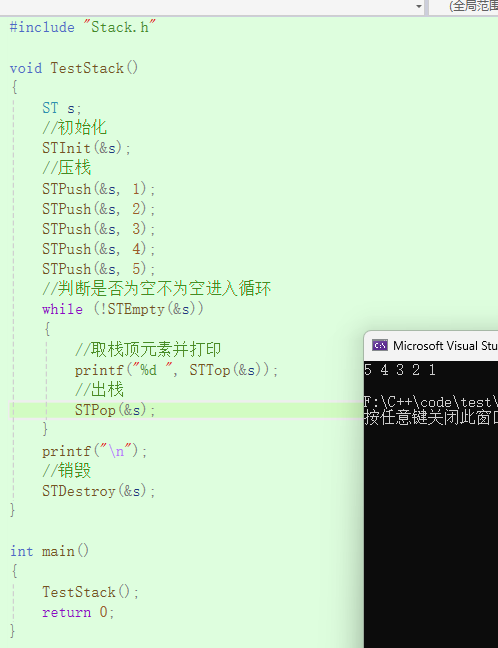目錄
- 一. 棧的認識
- 1. 棧的基本概念
- 2.棧的基本操作
- 二. 棧的核心優勢
- 1. 高效的時間復雜度
- 2. 簡潔的邏輯設計
- 3. 內存管理優化
- 三. 棧的代碼實現
- 1.棧的結構定義
- 2. 棧的初始化
- 3. 入棧 (動態擴容)
- 4. 出棧
- 5. 取棧頂數據
- 6. 判斷棧是否為空
- 7. 獲取棧的數據個數
- 8.銷毀
- 9.完整代碼展示
- 總結
一. 棧的認識
1. 棧的基本概念
棧是一種特殊的線性表,只允許在固定的一端進行插入和刪除元素的操作。進行數據插入和刪除操作的一端稱為棧頂,另一端稱為棧底。棧中的數據元素遵循后進先出的原則。
- 壓棧: 棧的插入操作叫做進棧/壓棧/入棧,入數據的元素在棧頂。
- 出棧: 棧的出棧也叫刪除操作,出數據也在棧頂。

2.棧的基本操作
| 操作 | 描述 | 時間復雜度 |
|---|---|---|
| Push(x) | 將元素x壓入棧頂 | O(1) |
| Pop() | 出棧彈出元素 | O(1) |
| Top() | 返回棧頂元素不出棧 | O(1) |
| Empty() | 檢查棧是否為空 | O(1) |
| Size() | 返回棧中元素數量 | O(1) |
二. 棧的核心優勢
1. 高效的時間復雜度
- 入棧、出棧、取棧頂均為常數時間O(1)操作,適合高頻調用場景。
- 專注“頂部”操作,避免不必要的復雜度。
- 對比其他數據結構:
數組:隨機訪問快O(1),但插入刪除中間元素移動數據O(n);
鏈表:插入刪除中間元素快O(1),但隨機訪問慢O(n);
2. 簡潔的邏輯設計
- 減少代碼的復雜度,設計更簡單。
- 通過壓棧和出棧自動維護操作順序,無需手動跟蹤索引指針。
3. 內存管理優化
- 局部性原理:棧操作集中在頂部,數據訪問具有空間局部性,利用CPU緩存命中。
- 動態擴容策略:棧實現如動態數組通過按需擴容平衡時間和空間效率。
三. 棧的代碼實現
1.棧的結構定義
typedef struct Stack
{STDataType* a; // 動態數組,存儲棧里的元素int top; // 棧頂指針(初始為0,表示空棧)int capacity; // 棧的最大容量
}ST;
- a:用指針指向一塊內存。
- top:指向當前棧頂的元素初始為0,表示空棧
- capacity:棧的最大容量
2. 棧的初始化
//初始化
void STInit(ST* pst)
{pst->a = NULL;//top指向棧頂數據的下一個位置pst->capacity = pst->top = 0;
}
- 初始化指針賦值為NULL,capacity和top賦值為0。
3. 入棧 (動態擴容)
//入棧
void STPush(ST* pst, STDataType x)
{assert(pst);if (pst->capacity == pst->top){int newcapacity = pst->top == 0 ? 4 : 2 * pst->capacity;STDataType* newnode = (STDataType*)realloc(pst->a, newcapacity * sizeof(STDataType));if (newnode == NULL){perror("realloc fail");exit(-1);}pst->a = newnode;pst->capacity = newcapacity;}pst->a[pst->top] = x;pst->top++;
}
- 當capacity等于top時,如果為空則開辟4個空間,不為空時開辟當前空間的二倍。
- 將插入的值先存放在top下標位置再top++。
4. 出棧
//出棧
void STPop(ST* pst)
{assert(pst && pst->top>0);pst->top--;
}
- 直接top- - 限制訪問完成出棧。
5. 取棧頂數據
//取棧頂數據
STDataType STTop(ST* pst)
{assert(pst && pst->top>0);return pst->a[pst->top - 1];
}
- top的位置是在最后一個元素的下一個位置,所以取棧頂數據直接取top減1的下標。
6. 判斷棧是否為空
//判空
bool STEmpty(ST* pst)
{assert(pst);return pst->top == 0;
}
- 返回值是bool類型,如果top == 0則返回true。
7. 獲取棧的數據個數
//獲取數據個數
int STSize(ST* pst)
{assert(pst);return pst->top;
}
- 因為棧的位置是從0開始的,所以直接返回top就是棧內部的數據個數。
8.銷毀
//銷毀
void STDestroy(ST* pst)
{assert(pst);free(pst->a);pst->a = NULL;pst->top = pst->capacity = 0;
}
- 釋放掉開辟的空間,將開辟的空間置為NULL,把top和capacity也置為空。
9.完整代碼展示
- Stack.h
#pragma once
#include <stdio.h>
#include <stdlib.h>
#include <assert.h>
#include<stdbool.h>typedef int STDataType;typedef struct Stack
{STDataType* a;int top;int capacity;
}ST;//初始化
void STInit(ST* pst);//銷毀
void STDestroy(ST* pst);//入棧
void STPush(ST* pst, STDataType x);//出棧
void STPop(ST* pst);//取棧頂數據
STDataType STTop(ST* pst);//判空
bool STEmpty(ST* pst);//獲取數據個數
int STSize(ST* pst);
- Stack.c
#include "Stack.h"//初始化
void STInit(ST* pst)
{pst->a = NULL;//top指向棧頂數據的下一個位置pst->capacity = pst->top = 0;
}//銷毀
void STDestroy(ST* pst)
{assert(pst);free(pst->a);pst->a = NULL;pst->top = pst->capacity = 0;
}//入棧
void STPush(ST* pst, STDataType x)
{assert(pst);if (pst->capacity == pst->top){int newcapacity = pst->top == 0 ? 4 : 2 * pst->capacity;STDataType* newnode = (STDataType*)realloc(pst->a, newcapacity * sizeof(STDataType));if (newnode == NULL){perror("realloc fail");exit(-1);}pst->a = newnode;pst->capacity = newcapacity;}pst->a[pst->top] = x;pst->top++;
}//出棧
void STPop(ST* pst)
{assert(pst && pst->top>0);pst->top--;
}//取棧頂數據
STDataType STTop(ST* pst)
{assert(pst && pst->top>0);return pst->a[pst->top - 1];
}//判空 等于0就為真
bool STEmpty(ST* pst)
{assert(pst);return pst->top == 0;
}//獲取數據個數
int STSize(ST* pst)
{assert(pst);return pst->top;
}

入棧順序為:1 2 3 4 5
出棧順序為:5 4 3 2 1
總結
根據上述講解,相信大家對棧有更深層的理解了。棧是程序運行時內存管理的核心區域之一,遵循后進先出原則,由操作系統或運行時環境自動分配和釋放,無需顯式干預。其設計目標是高效管理函數調用和局部變量,但受限于固定大小,需謹慎使用以避免溢出。合理的使用棧能讓程序又快又穩,濫用則容易崩潰。本篇文章到這里就結束了,感謝大家的閱讀,你們的點贊收藏加關注就是博主最大的動力。
《前期回顧》
【數據結構】——順序表鏈表(超詳細解析!!!)
C語言——結構體指南(小白一看就懂!!!)
力扣(LeetCode) ——移除鏈表元素(C語言)









![[ Mybatis 多表關聯查詢 ] resultMap](http://pic.xiahunao.cn/[ Mybatis 多表關聯查詢 ] resultMap)









